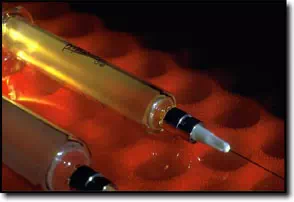 Wyoming Wyoming
Medical/Infectious Waste
Background Information
Medical/Infectious Waste Definition
Regulation of Medical/Infectious Waste
OSHA Regulations
Statutes, Regulations and Guidelines
Contacts
Background Information
Medical waste differs from hazardous waste. Hazardous waste is regulated by the US EPA (and related state rules) under the Resource Conservation and Recovery Act. Medical waste is not covered federal environmental laws or US EPA regulations (with the exception of a medical waste that also meets the definition of hazardous waste). Rather, medical waste is mostly controlled by state law and associated regulations. In addition to state environmental agency laws/rules, aspects of medical waste management are also controlled by the Occupational Safety & Health Administration (federal and/or state) and Department of Transportation (federal and state).
Each of our 50 states have developed rules and implemented regulations for medical waste. The state rules vary to some extent, including terminology. Depending on which state you live in, you may hear the terms regulated medical waste, biohazardous waste or infectious medical waste. In most cases, these terms all refer to the same thing: that portion of the medical waste stream that may be contaminated by blood, body fluids or other potentially infectious materials, thus posing a significant risk of transmitting infection.
Most states have regulations covering packaging, storage, and transportation of medical waste. Some states require health care facilities to register and/or obtain a permit. State rules may also cover the development of contingency plans, on-site treatment, training, waste tracking, recordkeeping, and reporting.
In most states, the environmental protection agency is primarily responsible for developing and enforcing regulations for medical waste management and disposal. Although in some states, the department of health may play an important role or even serve as the primary regulatory agency. Where both agencies are involved, typically the department of health is responsible for on-site management and the environmental agency is responsible for transportation and disposal.
OSHA, whether it is the U.S. Department of Labor Occupational Safety & Health Administration or an OSHA state program (24 states operate their own program), regulates several aspects of medical waste, including management of sharps, requirements for containers that hold or store medical waste, labeling of medical waste bags/containers, and employee training. These standards are designed to protect healthcare workers from the risk of exposure to bloodborne pathogens. However, they also help to systematically manage wastes, which benefit the public and environment.
Regulated medical waste is defined by the US Department of Transportation as a hazardous material. DOT rules mostly apply to transporters rather than healthcare facilities; although, knowledge of these rules is important because of the liability associated with shipping waste off-site.
Medical/Infectious Waste Definition
Medical/infectious waste is means any waste
generated in the diagnosis, treatment, or immunization of human beings
or animals. The definition of medical/infectious waste does not include
hazardous waste; household waste; ash from incineration of medical/infectious
waste, once the incineration process has been completed; human corpses,
remains, and anatomical parts that are intended for interment or cremation;
or domestic sewage materials. Examples of medical/infectious waste include:
- Cultures and stocks of infectious agents and associated
biologicals, including: cultures from medical and pathological laboratories;
cultures and stocks of infectious agents from research and industrial
laboratories; wastes from the production of biologicals; discarded
live and attenuated vaccines; and culture dishes and devices used to
transfer, inoculate, and mix cultures.
- Human pathological waste, including tissues, organs,
and body parts and body fluids that are removed during surgery or autopsy,
or other medical procedures, and specimens of body fluids and their
containers.
- Human blood and blood products including:
- Liquid waste human blood;
- Products of blood;
- Items saturated and/or dripping with human blood;
or
- Items that were saturated and/or dripping with human
blood that are now caked with dried human blood; including serum, plasma,
and other blood components, and their containers, which were used or
intended for use in either patient care, testing and laboratory analysis
or the development of pharmaceuticals. Intravenous bags are also included
in this category.
- Sharps that have been used in animal or human patient
care or treatment or in medical, research or industrial laboratories.
- Animal waste including contaminated animal carcasses,
body parts, and bedding of animals that were known to have been exposed
to infectious agents during research (including research in veterinary
hospitals), production of biologicals or testing of pharmaceuticals.
- Isolation wastes including biological waste and
discarded materials contaminated with blood, excretions, exudates,
or secretions from humans who are isolated to protect others from certain
highly communicable diseases, or isolated animals known to be infected
with highly communicable diseases.
- Unused sharps including the following unused, discarded
sharps: hypodermic needles, suture needles, syringes, and scalpel blades.
Regulation of Medical/Infectious
Waste
Environmental Regulations
Wyoming does not have specific environmental regulations
applicable to healthcare facilities for medical/infectious wastes, except
where healthcare facilities operate an incinerator for processing medical/infectious
waste (see Wyoming Air Quality Standards
and Regulations Chapter 4, Section 5). These rules are enforced
by the Wyoming Department of Environmental
Quality.
OSHA Regulations
In addition to the state medical waste incinerator
regulations there are some Occupational Safety and Health Administration
(OSHA) rules that apply to medical/infectious waste. Wyoming is one
of 24 states operating an approved occupational safety and health program. This
program is operated by the Occupational Safety and Health Administration of the
Department of Employment.
Statutes, Regulations
and Guidelines
Solid Waste
Management Rules (Chapter 15, Solid Waste Rules and Regulations
Contacts
Wyoming Department of Health
More Information
None located. |

